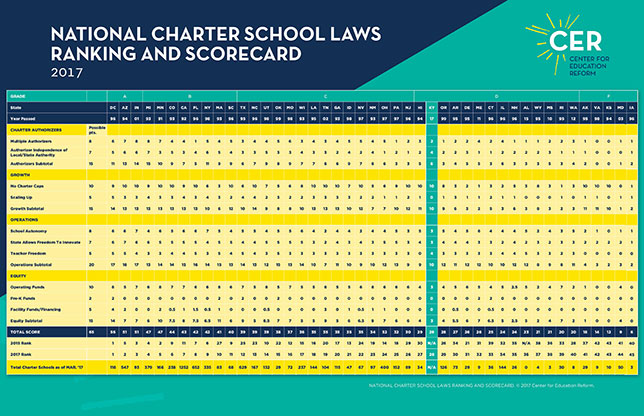Policy
Scorecard: Onerous State Regs Inhibit Public Charter School Growth
- By Dian Schaffhauser
- 04/06/17
Washington, D.C., with its 118 charter schools, came out on top this year in a national public charter school law ranking, just as it did in 2015. Second was Arizona, and third was Indiana. What makes for good laws regarding charters? According to the Center for Education Reform, which has examined the regulatory environment around charters every year since 1996, the best states emphasize charter independence and innovation.
The CER has long emphasized charter schools as a route for improving educational opportunities. The organization views charter laws put in place by states with favor when they allow people to create schools that are "independent, in oversight and operations, from the traditional school bureaucracies"; when they give schools "wide latitude" in their operations without imposing "onerous administration rules and regulations"; and when they allow parents to choose from as many schools as possible to "best meet the needs of their students."
Currently, the country has 7,000 charter schools, serving about 6 percent of the total number of students in public education. That's not a sufficient number to serve the demand, suggested CER, especially when traditional schools seem unable to influence the "overall improvement in U.S. student achievement on the National Assessment [of Education Progress] (NAEP)."
In its evaluation process CER examined four broad areas: what types of entities can authorize a charter, whether the state has imposed a cap on the number of charters that can be authorized, the amount of autonomy schools and teachers in charters get and what funding looks like. Each category earns the state points, which are added up to determine rank in the listing. Out of a total of 65 possible points, the District of Columbia earned 56 points; and Arizona and Indiana each attained 51 points. (Arizona beat Indiana in the ranking because it has 547 charter schools compared to Indiana's 93.)

Click for full-size image.
With its ranking CER also determined that fewer than a quarter of states have earned "above-average grades" with their charter laws. Those that excel, the organization noted, have several aspects in common:
- Entities besides school boards can authorize charter schools. In particular, some states with "strong charter laws" also bring in universities as "incredibly sophisticated and successful charter school authorizers." As the report noted, "Universities combine expertise and operational capabilities of a robust educational institution with the independence to embrace cutting edge teaching methods that move the needle for students."
- They follow the law, such as making sure to fund schools equitably when that's what the regulations say to do.
- States also rank higher where schools are allowed "to innovate" and aren't required to comply with conditions forcing them to "look and operate like traditional public schools."
"Risk-averse, highly bureaucratic state and local actors are causing the stagnation" of charters, the report asserted. "It comes not just from opponents, but from heavy-handed friends. Their heavy reliance on government to solve perceived issues of quality will bring charter schools to a screeching halt unless the policies they espouse reverse course."
The report and the scorecard are available on the Center for Education Reform website here.
About the Author
Dian Schaffhauser is a former senior contributing editor for 1105 Media's education publications THE Journal, Campus Technology and Spaces4Learning.